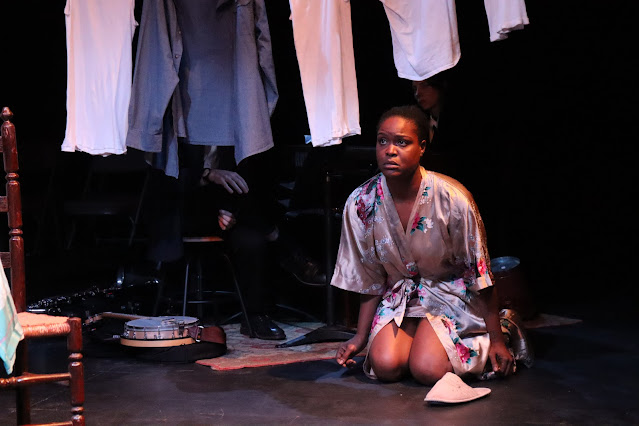Review: "AMARA SAPIENZA" Trains its Light on an Unruly Woman Artist
AMARA SAPIENZA. To my mother.
Written and directed by Giulia Bocciero
Presented at Theaterlab (357 W 36th St., 3rd floor, Manhattan, NYC), May 15, 2025, and BAAD (2474 Westchester Ave, Bronx, NYC), May 16, 2025
 |
| AMARA SAPIENZA. Photo courtesy of Emily Owens PR. |
Among the phrases in a recorded voiceover played during the play's opening, "Remember me" is repeated, an injunction from Sapienza, via this play, to the audience and the world. Sapienza was born in the city of Catania, in Sicily, the emblem of which is an elephant statue, known as u Liotru, and, after performer Alice Camoriano emerges, silently bearing a lighted ball, from a trunk (with its multiple interpretive possibilities, from storehouse to grave) at one end of the performance space, we are told the first part of a fairy-tale-esque story of a young girl whose desired encounter with a local elephant (again, offering multiple interpretive identifications) does not go in the way that she envisioned. The performance area is defined by a wide sheet of white paper that stretches from the trunk at one end and curves up into a vertical wall at the other. Camoriano spends most of the remainder of the performance writing out Sapienza's poem "To My Mother" ("A mia madre") on this paper, beginning at its vertical end and making her way back towards the trunk, at one juncture trading swooping, spiraling forms for the horizontal lines with which she begins, and often emphasizing through the almost dance-like enactment of her transcription the physicality of the act or writing, even of words themselves.
At the conclusion of the first part of the elephant story, Bocciero too, even more unexpectedly than Camoriano, her costume adorned with yet more words, arises from the trunk bearing a different, book-like light, which she also uses to represent a seagull during the continuation of the young girl's story. Bocciero will herself represent both Sapienza and others connected with her, as the play moves through moments including Sapienza's desire to become an actor, a lament for what Rome has become (this beautifully sung by Bocciero), and rejections from publishers of Sapienza's now highly regarded novel L'arte della gioia (The Art of Joy), which included a bisexual woman protagonist and was not published until two years after her death. The representation of an explosion, involving one of the production's numerous impactful uses of lighting changes, briefly halts even the transcription before we hear about the destruction of the Catanian neighborhood of San Berillo by the Christian Democrats for an urban renewal plan that displaced 30,000 people before being abandoned after a decade. At one point, the play poetically catalogues the smells–good and bad–of Catania, and Michel Foucault would certainly agree with Sapienza's remark in a section about her imprisonment that one can know a nation best through its hospitals, prisons, and asylums. At another point, the actors break into a joyous, gender-bending dance to Edith Piaf, and the end of Camoriano's transcription coincides with contemplations of death, and of both potential remembrance and displacement after death. Even as AMARA SAPIENZA considers these issues, with its expressive, physically eloquent performances, atmospheric production design, and echoes Sapienza's unconventionality in its own, the production itself contributes undeniably and meaningfully to the remembrance of a significant, underrecognized woman artist.
-John R. Ziegler and Leah Richards
More from In Scena! 2025
News: In Scena! Italian Theater Festival NY Announces Venues and Performance Schedule for 2025 Festival
Review: "Alfredino" Taps into an Emotional Wellspring
Review: "In the Name of Mary" Sees Love Cut Short
Review: One Migrant Undergoes a Sea Change in "Lampedusa Beach"
Review: "The Popess" Looks Back to Spotlight Forward-Looking Women
Review: In "Pelle," the Beast *Is* Beauty
Review: "The Perky Theresas" Calls Up a Fond Remembrance of Aunts Past
Review: "My Mama Notarizes & Also Makes Risotto" Tells–and Sings–a Story About Stories
Review: A More Concentrated and Contemporary "Six Characters in Search of an Author"
Review: In "Mater Familias," the More Things Change, the More a Family Stays the Same



Comments
Post a Comment